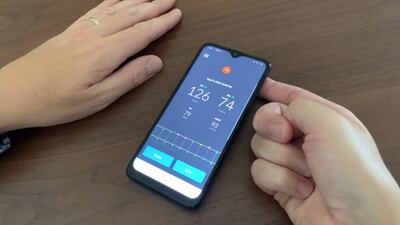
Telehealth is becoming a fundamental feature of every corporate health plan in the UAE. Reuters

The oxygen saturation monitor on the Apple Watch measures SPo2 and is 'very close to the clinical result', said Dr Habib. EPA

Dr Habib advised patients with chronic health problems to buy a pulse oximeter to monitor their blood oxygen levels, an important signal that could help diagnose an infection from afar. EPA

'These wearable devices won’t give you a specific diagnosis for an illness or disease, but it will show you if something is unusual,' said Dr Habib. Antonie Robertson/The National

Fitness trackers can record daily steps, sleep patterns, calorie intake, mood and progress towards exercise goals. AP

Tech firm Biospectal developed the OptiBP app that allows blood pressure to be monitored effectively using a smartphone’s camera. Photo: Biospectal

Telehealth is becoming a fundamental feature of every corporate health plan in the UAE. Reuters

The oxygen saturation monitor on the Apple Watch measures SPo2 and is 'very close to the clinical result', said Dr Habib. EPA

Dr Habib advised patients with chronic health problems to buy a pulse oximeter to monitor their blood oxygen levels, an important signal that could help diagnose an infection from afar. EPA

'These wearable devices won’t give you a specific diagnosis for an illness or disease, but it will show you if something is unusual,' said Dr Habib. Antonie Robertson/The National

Fitness trackers can record daily steps, sleep patterns, calorie intake, mood and progress towards exercise goals. AP

Tech firm Biospectal developed the OptiBP app that allows blood pressure to be monitored effectively using a smartphone’s camera. Photo: Biospectal

Telehealth is becoming a fundamental feature of every corporate health plan in the UAE. Reuters
How your smart watch could be the first to detect problems in your health
Doctors can use data from a patient's wearable device to catch the initial stages of diseases such as diabetes or Parkinson's

Nick Webster
22 February, 2022
- Listen In English
- Listen In Arabic